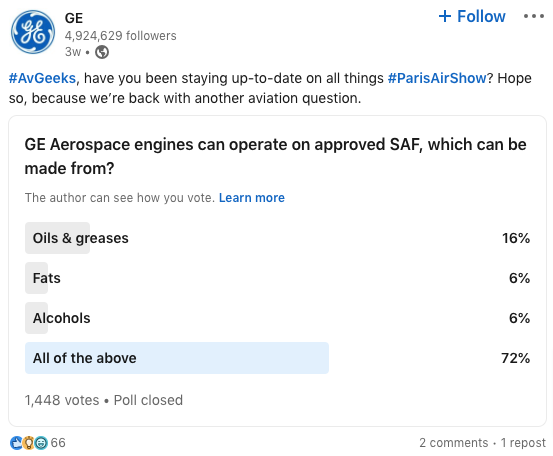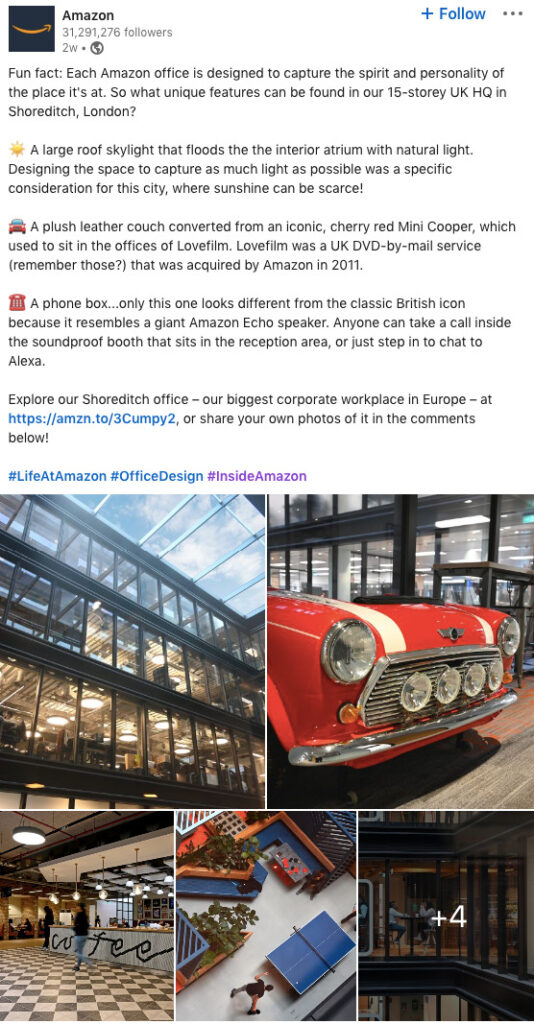LinkedIn is the world’s largest professional networking site, with over 930 million members in more than 200 countries and territories.
As LinkedIn has matured, it has become a cohesive platform that allows professionals to connect, build their networks and identify new opportunities seamlessly.
But LinkedIn isn’t just about finding a new job (or talent). As a result, the audience of LinkedIn is different from any other social media site:
- They’re comparatively affluent. 53% of LinkedIn users in the US have a high monthly household income, while 29% are in middle-income households.
- They’re well-educated. One in three US LinkedIn users has a bachelor’s degree or equivalent, and one-quarter have a master’s degree or equivalent.
- They include top executives. LinkedIn is #1 among chief execs, with 97% of all Fortune 500 CEOs on social media using the platform.
- They wield buying power. Four in five LinkedIn members drive business decisions, while LinkedIn audiences have twice the buying power of the average online audience.
These demographics make LinkedIn an enticing and important channel for brands, so it’s no surprise that 97% of B2B marketers use LinkedIn in their content marketing efforts.
But given its professional nature, brands must stay in tune with what their LinkedIn audiences crave.
The LinkedIn audience responds to stories that offer a deeper look at companies and those working there. As a result, LinkedIn has become the go-to social media site for amplifying employee voices, developing thought leadership, sharing behind-the-scenes stories, and starting conversations.
If your brand is considering LinkedIn, your content strategy should be the top priority. To help you get the creative juices flowing, we’ve developed a list of best-in-class examples from 10 enterprise brands.
1. GE Engages Audiences With LinkedIn Surveys
As social media marketers, it can sometimes feel as if you’re shouting into the void rather than having genuine, two-way conversations with your audience.
GE is always looking for ways to boost engagement with its LinkedIn content. One approach is to run in-platform polls — a tactic it used multiple times during the 2023 Paris Air Show:

Surveys give followers a quick and easy way to join the conversation without investing time in writing a comment.
And they also help you gather audience insights. GE’s Paris Air Show polls allowed its marketing team to gauge audience knowledge of key industry-related issues and the company’s announcements, which in turn helps it understand the effectiveness of its messaging.
Another critical point: LinkedIn likes it when you encourage people to engage within its platform rather than sending your audience to external sites like any social network. Sharing this type of content could help boost your reach in the long term.
RESULTS: GE’s Paris Air Show surveys generated thousands of votes and hundreds of post engagements.
TAKEAWAY: Use LinkedIn polls to engage your audience and understand their knowledge or opinions on key company and industry-related issues.
2. Amazon Showcases Office Life
LinkedIn has become the go-to platform for candidates and recruiters, with 61 million people using the site to search for jobs each week and eight people hired on LinkedIn every minute. It makes sense to factor talent attraction into your LinkedIn content strategy.
Amazon is well aware of this. The e-commerce giant regularly shares content that lifts the lid on what it’s like to work for Amazon, from discussing employee rewards and benefits to showcasing its most innovative and exciting workspaces:
The brand designs these posts to make Amazon look like an attractive workplace, helping the company slash its recruitment costs.
RESULTS: The above post generated over 6,200 engagements, 180+ comments, and almost 300 reposts at the time of writing, while the dedicated hashtag #InsideAmazon has close to 2,000 followers.
TAKEAWAY: Give your LinkedIn audience a glimpse of working life at your company and share information about employee benefits to engage potential candidates.
3. Best Buy Shows Support for Good Causes
Best Buy often uses LinkedIn to showcase its support for good causes, such as its Best Buy Teen Tech Center initiative, which provides tech access, training, and mentorship to young people in disinvested communities.
It’s easy to see why. Supporting good causes helps you give something back to your community while positioning your brand as a company that cares.
And from a marketing perspective, it’s a highly effective way to engage your followers — especially younger audiences. Research from YPulse found that three-quarters of Gen Z and Millennial responders actively seek out brands that support causes they believe in, with two-fifths doing so always or often.
RESULTS: At the time of writing, Best Buy’s six most recent posts about its Teen Tech Center initiative have generated an average of around 250 engagements per post (not to mention hundreds of total comments and shares).
TAKEAWAY: Whether raising funds for a charity or leading your own Teen Tech Center-style initiative, promoting your support for good causes can boost the perception of your brand, particularly among younger followers.
4. Sephora Shares Human Voices
Social media is all about human connections, so it makes sense to showcase the real people that work for your organization rather than solely speaking as a faceless brand.
For instance, beauty brand Sephora frequently shares insights and interviews with senior leaders, helping audiences glean a deeper understanding of the decisions guiding the company’s plans and strategies:
This is a smart approach, with research indicating that real people are vital to building authentic brand relationships. For instance, research from Sprout Social revealed that 70% of social media users feel more connected to brands when their CEO has an active social media presence.
Given that Guillaume Motte had been in the role for less than a year at the time of writing, it made sense for Sephora to share this post — and his LinkedIn profile — to help boost his presence and encourage followers to engage with his content.
RESULTS: The above post generated over 1,000 reactions, plus dozens of reposts and comments.
TAKEAWAY: Share interviews with senior leaders to help your audience feel more connected with your brand.
5. Intel Communicates Innovations in Layman’s Terms
As one of the world’s biggest tech companies, Intel constantly seeks innovation.
Naturally, when it finds a new way to solve a problem or develops a new technology, it wants to share the results with its audience.
But there’s a problem: only a relatively small proportion of its followers will be sufficiently tech-savvy to grasp the relevance and importance of those announcements. Because how many of us really understand the first thing about computer chips or artificial intelligence?
For that reason, Intel strives to communicate these key developments in human language that anyone can understand, often using real-world examples to explain why they matter. This post about how Intel’s products support the inspection of water lines below Washington, DC, is a prime example:
The simple, friendly-looking animation makes the news seem more accessible, while the copy spells out the key messages in easy-to-understand terms.
RESULTS: This video attracted almost 2,000 reactions at the time of writing and over 100 reposts.
TAKEAWAY: When communicating a company development, steer clear of buzzwords and other complex language to ensure your messaging hits home with the widest possible audience.
6. USC Promotes Thought Leadership
Thought leadership content is your opportunity to demonstrate your brand’s expertise and position you at the forefront of innovation in your niche or industry, so it should play a key role in your LinkedIn strategy.
The University of Southern California clearly understands this. It regularly shares content highlighting the unique work of its researchers and how their efforts stand to benefit the wider world.
This commitment to thought leadership is important for higher education institutions like USC, helping them attract new students, engage existing ones, and attract funding from alums.
RESULTS: This post racked up close to 800 reactions at the time of writing.
TAKEAWAY: Use thought leadership content to promote the innovative work at your organization and demonstrate your subject-matter expertise.
7. Microsoft Boosts Engagement With Monthly Newsletter
LinkedIn Newsletters are a (relatively) new feature that allows you to share long-form content with subscribers, who’ll be notified when your latest newsletter comes out.
As the owner of LinkedIn, Microsoft is understandably keen to showcase newsletters, so it created its own: The Monthly Tech-In:
The benefits of newsletters are obvious. Like most social platforms, LinkedIn has pretty appalling organic reach — meaning only a tiny proportion of your followers will ever see most of your (non-paid) posts. By starting a newsletter and attracting subscribers, you can guarantee a chunk of your audience will get a heads-up when your latest issue drops.
RESULTS: At the time of writing, The Monthly Tech-In’s first two editions generated over 19,000 reactions and almost 350 comments — way more than Microsoft’s regular posts.
TAKEAWAY: Start your own LinkedIn Newsletter to overcome the platform’s low organic reach.
8. Accenture Shares (Relevant) Customer Success Stories
Reviews play an essential role in the path to purchase. For instance, 59% of tech buyers say reviews are an “impactful resource” for purchasing decisions. So it’s no surprise that Accenture, like any other B2B brand, is eager to share its biggest customer success stories.
However, Accenture’s approach is a little more sophisticated than most.
Rather than crowbarring any old customer case study into its LinkedIn content strategy, it often looks for the most relevant stories based on broader trends and events (such as sharing the above post on World Chocolate Day).
This tactic helps Accenture tap into a wider audience. And it also makes the content feel more timely and engaging.
RESULTS: As you can see, this post has racked up well over 1,000 reactions, not to mention more than 100 reposts. That’s impressive for success story-style content, which often isn’t super-shareable.
TAKEAWAY: Try to share customer success stories that align with current trends, industry news, or even awareness days to make them feel more relevant.
9. Toyota Shares Location-Specific Company Announcements
Like any multinational company, Toyota’s announcements can have a huge impact on the areas where its factories and other workplaces are located.
So it makes sense for the automotive giant to highlight the local communities that will be affected when sharing company news, just like this announcement regarding production of its new SUVs and batteries:
This news is likely to be well received in those locations — particularly given the sustainability angle, with research from NielsenIQ revealing that 48% of consumers want brands to take the lead on creating sustainable change.
RESULTS: This post generated almost 3,000 reactions and was reposted 150 times.
TAKEAWAY: If your organization serves (or has facilities in) multiple locations, highlight those locations when sharing relevant company announcements.
10. Google Gives Interns a Voice
We’ve already spoken about the value of sharing content from real people at your organization. As Google demonstrates here, this strategy doesn’t have to be limited to your CEO and other senior leaders:
Giving interns a voice provides a more ground-level view of what’s going on at your company, which makes for more relatable (and, often, engaging) content.
Plus, it can inspire others to apply for internships at your organization, helping you unearth the next generation of talent.
RESULTS: Cassandra’s story attracted more than 16,500 reactions, well over 300 comments, and 200+ reposts.
TAKEAWAY: Sharing the thoughts and experiences of interns and employees outside your senior management team is one of the best ways to humanize your company.
Final Thoughts
LinkedIn is the platform for digital networking, building connections and identifying opportunities.
For brands, it’s all about forging authentic connections with their audience through shared experiences. The best brands on LinkedIn achieve this through sharing employee and customer stories, showcasing innovations, and tapping into the conversations their audiences care about. What brands have you seen that are standing out on LinkedIn? Would you add any to this list?
Other posts you might enjoy:
- 7 Brands Achieving Killer Results on Facebook
- Nailed It: The 5 Best Brands on Snapchat
- The Next Big Thing in Social: Top 7 Brands Embracing TikTok
- Top 10 Brands Killing It on Instagram
To learn more about the latest social media platforms, join us at one of our upcoming social media strategy conferences.


 Image source
Image source Image source
Image source Image source
Image source Image source
Image source Image source
Image source






